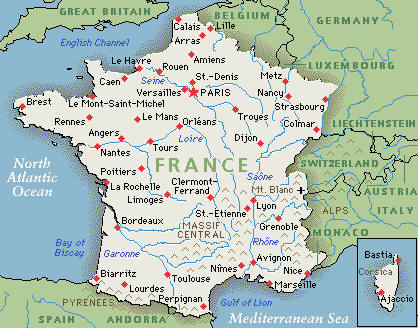 |
 |
 |

If you'd like to see our route through France, you can chart it on this map. Our trip took us down the eastern part of France. The first French city we passed after Belgium was Lille. We proceeded through Dijon and stopped in Lyon and Arles, a city in Provence near Avignon. We took highways and back roads, making sure we always had enough fuel, as there was a crippling strike against the price of gasoline nearly the entire time we visited. We never had trouble getting fuel when we needed it, but most stations on the country roads were closed or had long lines, reminiscent of the decades-ago energy crisis in the US. Soon after we crossed the border into Spain, we arrived in Gerona and moved on to Barcelona, a city just off this map, where we took a flight to Palma de Mallorca.

|
Lyon |
|
|
|
Lyon is the second city of France, the largest after Paris, and is considered by some to be the gastronomic capital of the world. The Presque'île is the center of Lyon, a strip of land between the Saône and Rhône rivers. Place Bellecour, shown at left, is a huge square, nearly empty except for a statue of Louis XIV in the middle.
|
|
Among Lyon's many attractive squares is this, the Place de la République. Part of Lyon's appeal is that the buildings so resemble the grandeur of Paris, yet the city's size is manageable. We had never seen so many public displays of romance, even in Paris, and the divisions of land due to the two rivers make each area very walkable. |
|
|
|
We think that the Place des Terraux at left is the crowning glory of Lyon's squares. The building straight ahead is the 17th century Hôtel de Ville (city hall). The fountain shown on the left side of the photo is the work of 19th century sculptor Bartholdi, creator of the Statue of Liberty. |
|
Arles |
|
|
|
We knew that we'd arrived in Provence because it was finally hot. This ancient Roman arena dominates the main part of town. It is one of the largest Roman arenas in existence and is still used for public events, including bullfights. Note the steel modern seating inside the ancient walls. The Roman colony at Arles was founded by Julius Caesar in 47 B.C. During the Barbarian and Saracen invasions in the Middle Ages, the arena was used as the town's fortification. More than 200 houses and two chapels were constructed inside. They were cleared out in 1930. |
|
Saint Trophime Church underwent transformation during the 11th, 12th, and 15th centuries. It is the site of the coronation of Frederic Barberossa in 1178 and the marriage between Yolande d'Aragon and Louis II of Anjou in 1389. The doorway, dating from the second half of the 12th century, is a masterpiece of intricate religious carvings. Its theme is the Last Judgment, and includes related images on the pillars, friezes, and all sides. |
|